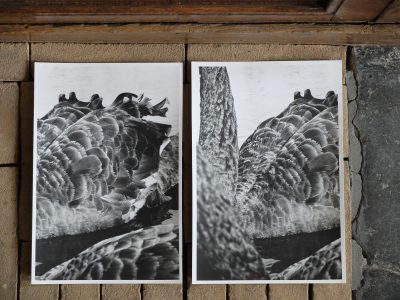Interview with Jason Hendrik Hansma
by Judith Spijksma

In the spring of 2016, artist Jason Hendrik Hansma (1988, Lahore, Pakistan) resided at Kunsthuis SYB in Beetsterzwaag. In his presentation in the local village church, two animals took center stage: a white peacock and a black swan. Interested in the white animal that is commonly known for its profusion of beautiful colors; and the black swan which is notorious for its rare occurence, Hansma made a black and white 16-mm film as well as several photographs in which the animals feature. In general, the artist is fascinated by the interaction between humans and objects; including the continuously shifting, intangible meanings and perception of the world around us.
The film you made, The Elemental that Faces, as well as several photographs, portrays two animals that possess rare properties, being their color or the lack thereof. Where did you find these animals? What was the impulse behind bringing them together in the film and subsequently presenting this in the local church in Beetsterzwaag?
I was reading on the white peacock and got interested in the effect of the colors of a “regular” peacock; the iridescence of its feathers and the way the hue of these colors changes when one moves around the animal due to the changing ways the feathers refract light. I discovered that there was a place near Beetsterzwaag that owns a white peacock, so I went there to film the bird on black and white film stock.
The peacock is a much-used-symbol for pride – and also color. As the peacock is a symbol of pride and color, swans are known for their elegance. On the other hand, the black swan, is historically quite rare. It is native to Western Australia, where the Frisian seafarer Willem de Vlamingh, as the first European, encountered what is now called the Swan River in Perth in 1696 (actual name: Derbarl Yerrigan). Until that day – so the story goes – black swans were known in Europe as a proverbial example of something that does not exist. And then there is the black-swan theory, whose name refers to that same saying. I found the black swans that feature in the film in Dalen (Drenthe). When I look at the photographs of the black swan, they appear as both positive and negative images at the same time. Something happens in the perception of the image which is not solely the result of the production process.
The film you made is a 16-mm black and white film. A meaningful choice since the color – or non-color – of the main subjects, the animals, is the guiding principle. Can you elaborate on your ideas on materials and the practice of making?
The artwork, its material, the medium, is the language. How does, for instance, a black and white film renders a bird in a certain way and how does that change the history of how a film or image is perceived? Or how does glass drip like honey and how is that a part of the conceptual underpinning of an artwork? This kind of material thinking is not about “how does A get translated into B?” but rather concerned with how the idiosyncrasies of the material fundamentally change the conceptual premise of the work, or even the exhibition and the surrounding space. Such ideas inspired me in reading works of theoretical physicist and feminist theorist Karen Barad who states that meaning is matter and matter is meaning. In other words, meaning is made possible through specific material practices. To me, however, just as you can leave an idea, you can leave a material, I like to think of meaning and material as happenings, rather than static. And in that way, material can be reworked in the future alongside new phenomena. So, I think it’s like being at the same time engaged with the material, and thinking about how it has its own idiosyncrasies – but also not getting obsessed with one’s definition of it: it should remain light. The different particularities of a material and how they inform the conceptual underpinning of an artwork is why I like to work with all kinds of media and materials, as material is actually thinking in itself.
In her book Meeting the Universe Halfway (2007) Barad tells this beautiful story about silver particles and the quest for understanding space quantization as a real phenomenon. I don’t know exactly how it works so I am gliding over all the technicalities. Some physicists were trying to make silver atoms appear on a glass plate. They were shooting these beams of silver atoms, but they wouldn’t appear, and they didn’t understand why. Then the studio assistant picked up the glass plate, and while looking at it, slowly the silver appeared on the plate. It turned out that he had a high dose of sulfur in his breath due to the cheap cigars he had been smoking. Barad states that to make these things visible there were so many aspects present in what had happened. First of all, he was a lab assistant (male, gender). He was poor, that’s why he was smoking cheap cigars with high dose sulfur (economic). Plus, the temperature, weather and locality of the laboratory all played a part in making this “immaterial” visible too. This way of thinking about making and authorship is crucial for it shows that many factors come into play and influence a particular outcome or affect. This is likewise, I believe, for an art viewership. It makes art highly volatile, but it also makes it highly inter-dependent because you never know when and how that part of gender, locality or economics plays a part in the perception of a work. So, as an artist, one might not be as important as we think we are. Just as the described physicist, one is not the sole creator of the experiment; rather one is a dependent agent. Thus, I too, do not feel the sole creator of an artwork or a show, but rather a participant in surrounding phenomena of meaning and matter.
A residency offers artists a free zone and allows them to explore and experiment without to think about results while, paradoxically, having the liability to produce and make a presentation of some kind of outcome. How do you look back in this respect on your residency in Beetsterzwaag?
During my stay in Beetsterzwaag, I developed a way of working and a rhythm, in part determined by the particularities of the daily life of the village. It enabled me to read quite a lot; I was reading for six or seven hours and then developing film in the bathroom. I wanted to make this movie, but the way of working – the time I had to do readings – made me also realize that I don’t want to work too much in a premeditated way. When I look at the work I made in SYB, the starting point of the work felt like I was finding very convenient ways of accessing or framing. For the black swans, for example, linking it to history and theory. I also realized that I don’t need to have any of this external information, but rather one can operate in a participatory way with material. It’s only when viewing the images now, do I see there is this shift occurring in perception.
It is always important to have some material structure or container such as film, text, or event so that you can engage ideas of a locality into it. However, when I was at SYB, it felt unproductive to make a container and shove things into that. And I think I realized that in general, this intentional way of working could result in the flattening of the idiosyncrasies of a landscape or people into what I had thought of it beforehand. I was at the same time reading a text by the Australian ecologist Deborah Bird Rose, and I found her ideas on slow writing and slow scholarship equally useful for my practice as an artist. She talks about how it’s necessary to split between academia and what she calls “real research,” or the split between “fast” and “slow” scholarship. Slow writing is dialogic, situated and context-specific whereas its counterpart is strategic and practiced with a distance towards its subject. There have been many other readings I did in Beetsterzwaag that I used for other shows or works afterward and are still influential. What I remember probably the most is reading on Buddhism without any clear trajectory or goal. So, I think that is also an important part of my practice. I do not perceive this period as linear in the sense that it is finished and completed with the making of the film. I don’t feel like I finished anything, as all works, ideas and materials are in constant stages of becoming and always folding in and out of different moments of perception.
